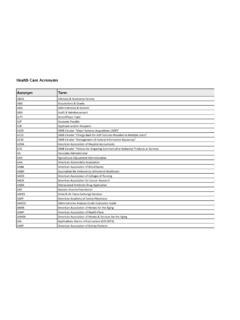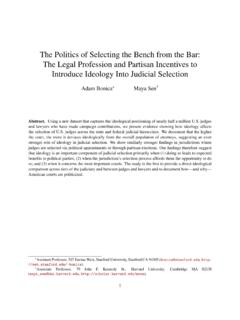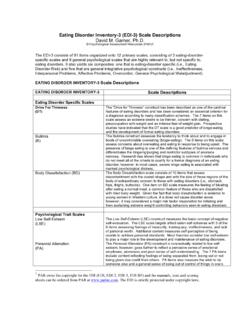Transcription of Adverse Childhood Experiences Prevention Strategy
1 National Center for Injury Prevention and Control Adverse Childhood Experiences Prevention Strategy National Center for Injury Prevention and Control Adverse Childhood Experiences Prevention Strategy FY2021-FY2024 Contributors:Office of Strategy and InnovationChristopher JonesSarah BaconGaya MyersAkadia Kacha-OchanaAisha MahmoodOffice of CommunicationTessa BurtonJennifer MiddlebrooksOffice of Policy and PartnershipsElizabeth SolhtalabJacqueline WatkinsOffice of ScienceArlene GreenspanGwendolyn CattledgeDivision of Injury PreventionAlexander CrosbyIgbo TochukwuDivision of Overdose PreventionLara DePadillaApril WisdomDivision of Violence PreventionPhyllis NiolonThomas SimonAdditionally.
2 We extend our gratitude to the NCIPC staff and partners whocontributed their time, insight, and determination to see thisstrategy planning effort through to the end. September 2020 National Center for Injury Prevention and Control Centers for Disease Control and Prevention Atlanta, Georgia Suggested Citation: Centers for Disease Control and Prevention . Adverse Childhood Experiences Prevention Strategy . Atlanta, GA: National Center for Injury Prevention and Control, Centers for Disease Control and Prevention , Adverse Childhood Experiences Prevention StrategyBackground on Adverse Childhood ExperiencesSafe, stable, nurturing relationships and environments are essential to children s health and wellbeing.
3 However, many children do not have these types of relationships or do not live in these types of environments, placing them at risk for Adverse Childhood Experiences with the potential for immediate and long-term negative health and social impacts. While all children are at risk for Adverse Experiences , numerous studies have documented inequities in such Experiences attributed to the historical, social, and economic environments in which some families live (Merrick et al., 2019). Adverse Childhood Experiences , or ACEs, are preventable, potentially traumatic events that occur in Childhood (0-1 7 years) such as neglect, experiencing or witnessing violence, and having a family member attempt or die by suicide.
4 Also included are aspects of a child s environment that can undermine their sense of safety, stability, and bonding, such as growing up in a household with substance use; mental health problems; or instability due to parental separation or incarceration of a parent, sibling or other member of the household (Figure 1) (CDC, 2019; Felitti et al., 1998). Importantly, these examples do not comprise an exhaustive list of all Childhood adversities, as there are other potentially traumatic Experiences , such as bullying, experiencing racism, and the death of a parent, that can also impact health and wellbeing.
5 Consideration of these forms of Childhood trauma and their negative impact on health over time also supports the National Center for Injury Prevention and Control s (Injury Center s) strategic focus on the intersection of ACEs, suicide, and overdose as critical threats to public health that are interrelated and preventable (Hulsey et al., 2020; Pham, Porta, and Biernesser, 2018). In addition, conditions such as living in under-resourced or racially segregated neighborhoods, frequently moving, being subjected to homelessness, or experiencing food insecurity can be traumatic and exacerbate the effects of other ACEs.
6 Finally, historical and ongoing traumas due to systemic racism and discrimination or the impacts of multigenerational poverty resulting from limited educational and economic opportunities intersect and exacerbate the experience of other ACEs, leading to disproportionate effects in certain populations (Nurious, Logan-Greene, and Green, 2012).Figure 1. What are Adverse Childhood Experiences ?ABUSEHOUSEHOLD CHALLENGES NEGLECTP hysicalEmotionalSexualPhysicalEmotionalM ental IllnessParent Treated ViolentlyDivorceIncarcerated RelativeSubstance AbuseWhat are ACES?
7 3 3 Adverse Childhood Experiences Prevention StrategyThe Childhood years, from the prenatal period to late adolescence, are the building block years that help set the stage for adult relationships, behaviors, health, and social outcomes throughout the lifespan. While some degree of stress and adversity is normal and an essential part of human development, exposure to frequent and prolonged adversity, especially in the absence of protective factors, can result in toxic stress ( , prolonged activation of the stress-response system).
8 A large and growing body of research indicates that toxic stress during Childhood can harm the most basic levels of the nervous, endocrine, and immune systems and that such exposures can even alter the physical structure of DNA (epigenetic effects) (Shonkoff & Phillips, 2000; Shonkoff, Garner, et al., 2012). Changes to the brain from toxic stress can affect such things as attention, impulsive behavior, decision-making, learning, emotion, and response to stress (Shonkoff, Garner, et al., 2012).In the absence of factors that can prevent or reduce toxic stress, children growing up under these conditions often struggle to learn and complete schooling (National Scientific Council on the Developing Child, 2010; Shonkoff, Garner, et al.)
9 , 2012). They are often at increased risk of becoming involved in crime and violence (Duke, Pettingell, et al., 2010; Fox, Pereza, et al., 2015), using alcohol or drugs (Dube, Anda, et al., 2002; Dube, Felitti, et al., 2003), and engaging in other health-risk behaviors ( , early initiation of sexual activity; unprotected sex; and suicide attempts) (Hillis, Anda, et al., 2001; Hillis, Anda, et al., 2004; Dube, Anda, et al., 2001; Duke, Pettingell, et al., 2010). They are susceptible to disease, illness, and mental health challenges over their lifetimes (Shonkoff, Garner, et al.
10 , 2012; Edwards, Anda, et al., 2005; Gilbert, Breiding, et al., 2015). Children growing up with toxic stress may have difficulty forming healthy and stable relationships (Hughes, Bellis, et al, 2017; Merrick et al, 2019; Shonkoff et al, 2012). They may also have unstable work histories as adults and struggle with finances, family, jobs, and depression throughout life the effects of which can be passed on to their own children (Shonkoff, Garner, et al., 2012; Chapman, Anda, et al., 2004; Felitti, Anda, et al.

















